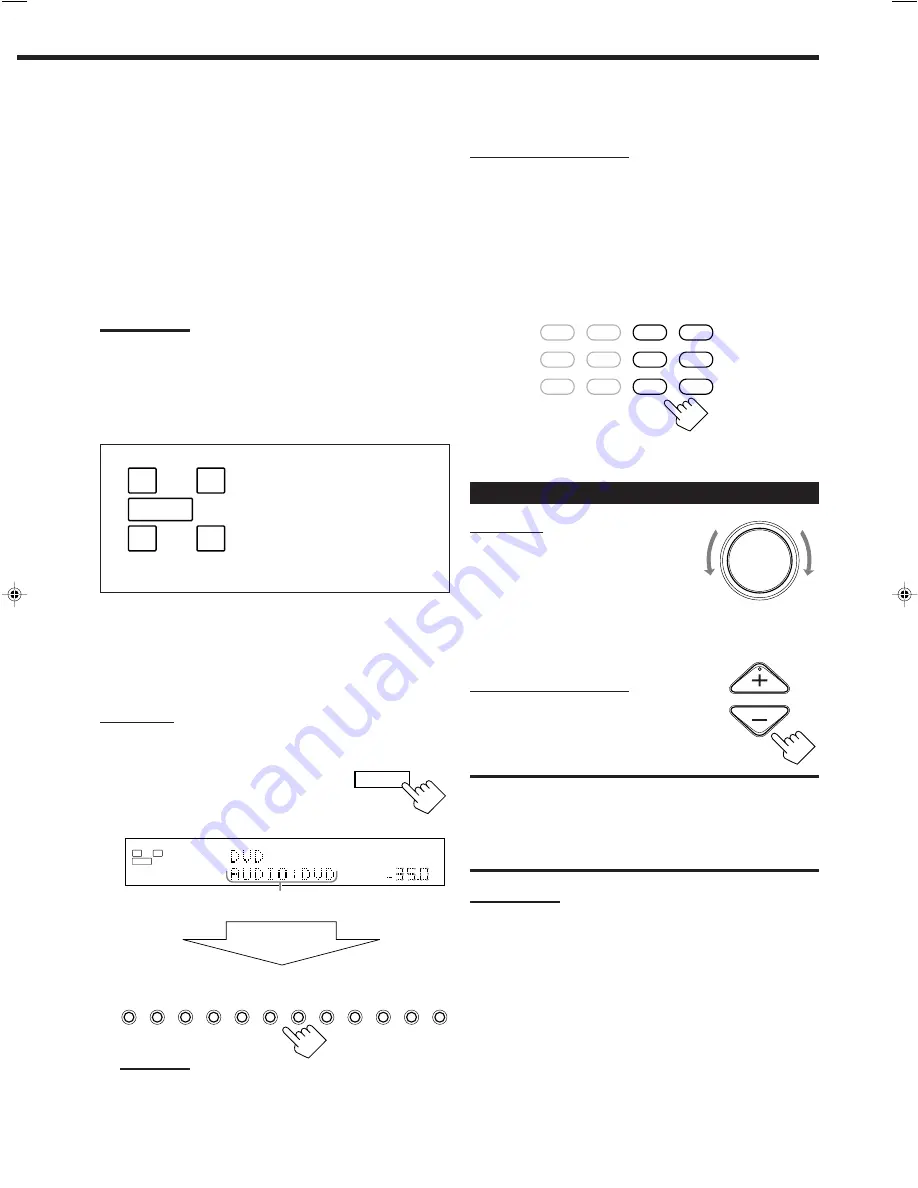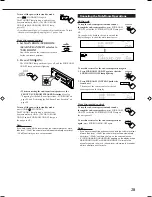
22
The signal indicators light up to indicate the incoming signals.
L
: • When digital input is selected: Lights up when the left
channel signal comes in.
• When analog input is selected: Always lights up.
R
: • When digital input is selected: Lights up when the right
channel signal comes in.
• When analog input is selected: Always lights up.
C
: Lights up when the center channel signal comes in.
LFE
: Lights up when the LFE channel signal comes in.
LS
: Lights up when the left surround channel signal comes in.
RS
: Lights up when the right surround channel signal comes in.
S
: Lights up when the monaural surround channel signal
comes in.
SB
: Lights up when the surround back channel signal comes in.
Note:
When “DVD MULTI” is selected as the source, “L,” “C,” “R,” “LFE,” “LS”
and “RS” light up.
To obtain the best performance of this receiver while using the
Surround/DSP modes, check the speaker and signal indicators on
the display carefully and set the speakers correctly.
Selecting different sources for picture and
sound
While watching pictures from a video source, you can listen to
sound of a different source.
On the unit:
You can select any component as the sound source.
1. Press SOUND SELECTOR (inside
the front door) while viewing the
picture from a video component such
as the VCR or DVD player, etc.
2. Press one of the source selecting buttons.
Note:
When “TV” has been assigned as the source name to the TV/DBS
button, it does not work. To change the source name, see
“Changing the Source Name” on page 25.
LFE
SUBWFR
L
C
R
LS
RS
SB
SB
Ex. No sound comes out of the
center speaker and surround
back speakers though center
channel and surround back
signals are coming into this
receiver.
SOUND
SELECTOR
L
ANALOG
SPEAKERS
VOLUME
1
SUBWFR
R
dB
“AUDIO” appears followed by the current sound
source.
Within
5 seconds
DVD
DVD MULTI
VCR 1
VCR 2
TV/DBS
CD
VIDEO
PHONO
TAPE/MD
CDR
FM
AM
To match the video source and sound source again, repeat steps 1
and 2, and select the same sound source as the video source in step 2.
From the remote control:
You can select only audio component as the sound source when
using the remote control.
• Once you have selected a video source, pictures of the selected
source are sent to the TV until you select another video source.
Press one of the audio source selecting buttons—
PHONO, CD, TAPE/MD, CDR, FM, AM—while
viewing the picture from a video component such as
the VCR or DVD player, etc.
Adjusting the Main Room Volume
On the unit:
To increase the volume, turn MASTER
VOLUME clockwise.
To decrease the volume, turn it
counterclockwise.
• When you turn MASTER VOLUME rapidly,
the volume level also changes rapidly.
• When you turn MASTER VOLUME slowly, the volume level also
changes slowly.
From the remote control:
To increase the volume, press .
To decrease the volume, press VOLUME –.
CAUTIONS:
• Always set the volume to the minimum before starting any source. If
the volume is set at a high level, the sudden blast of sound energy
can permanently damage your hearing and/or ruin your speakers.
• Be careful not to turn up the volume so high when controlling the
receiver without listening to the playback sound. For example, when
adjusting the volume level in the sub-room from the main room.
Notes:
• The volume level can be adjusted within the range of “– – – dB”
(minimum) to “+18.0 dB” (maximum).
• If you set One Touch Operation to “ON” (see page 40), you do not
have to adjust the volume level each time you change the source. It
is automatically set to the stored level.
(However, if you have turned off the receiver with the volume level
set at more than level “–35 dB,” the volume level will be
automatically set at level “–35 dB” next time you turn on the
receiver.)
DVD
DVD MULTI
CD
CDR
PHONO
TAPE/MD
AM
VCR 1
VCR 2
FM
VIDEO
TV/DBS
Down
MASTER VOLUME
Up
VOLUME
EN17-30_RX-DP10VBK[J]_f
01.6.19, 1:13 PM
22















































